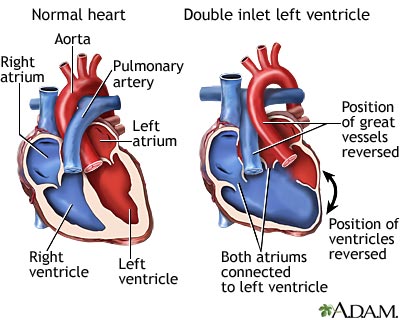Alternate Names : DILV, Single ventricle, Common ventricle
Definition
Double inlet left ventricle (DILV) is a congenital heart defect that affects the valves of the heart. Congenital means it is present from birth. Babies born with this condition have only one working lower chamber (ventricle) in their heart.
Overview, Causes, & Risk Factors
DILV is one of several heart defects known as single (or common) ventricle defects. People with this condition generally have a large left ventricle (the pumping chamber of the heart that supplies the body with blood), and a small right ventricle (the pumping chamber that supplies the lungs with blood).
In the normal heart, the right and left lower chambers (ventricles) receive blood from the right and left upper chambers (atria). The pulmonary artery then carries oxygen-poor blood to the lungs from the right ventricle, and the aorta carries oxygen-rich heart to the rest of the body from the left ventricle.
However, in those with DILV, only the left lower heart chamber is developed, and both upper chambers carry blood into this ventricle. This means that oxygen-rich blood mixes with oxygen-poor blood. The mixture is then carried into the body and the lungs.
DILV can occur with transposition of the great vessels (in which the aorta arises from the small right ventricle and the pulmonary artery arises from the left ventricle), or it can occur with the arteries arising from the normal places. Blood flows from the right to left ventricles through a ventricular septal defect (VSD).
Double inlet left ventricle occurs in about 5 – 10 of 100,000 live births. The problem most likely occurs early in the pregnancy, when the baby’s heart develops. However, the exact cause of DILV is unknown.
Patients with DILV often also have other heart problems, such as:
- Coarctation of the aorta
- Pulmonary atresia
- Pulmonary valve stenosis
Pictures & Images
Double inlet left ventricle
 In double inlet left ventricle only the left lower heart chamber (left ventricle) is developed, and both upper chambers carry blood into this ventricle. A small, poorly developed right ventricle may be present. Double inlet left ventricle is one of several heart defects known as single (or common) ventricle defects, as there is essentially only one pumping chamber in the heart.
In double inlet left ventricle only the left lower heart chamber (left ventricle) is developed, and both upper chambers carry blood into this ventricle. A small, poorly developed right ventricle may be present. Double inlet left ventricle is one of several heart defects known as single (or common) ventricle defects, as there is essentially only one pumping chamber in the heart.
-
Double inlet left ventricle : Overview, Causes, & Risk Factors
-
Double inlet left ventricle : Symptoms & Signs, Diagnosis & Tests
-
Double inlet left ventricle : Treatment



Review Date : 4/30/2008
Reviewed By : Mark A Fogel, MD, FACC, FAAP, Associate Professor of Pediatrics and Radiology, Director of Cardiac MR, The Children’s Hospital of Philadelphia, Division of Cardiology, Philadelphia, PA. Also reviewed by David Zieve, MD, MHA, Medical Director, A.D.A.M., Inc.
The information provided herein should not be used during any medical emergency or for the diagnosis or treatment of any medical condition. A licensed medical professional should be consulted for diagnosis and treatment of any and all medical conditions. Call 911 for all medical emergencies. Links to other sites are provided for information only — they do not constitute endorsements of those other sites. © 1997- 2010 A.D.A.M., Inc. Any duplication or distribution of the information contained herein is strictly prohibited.
